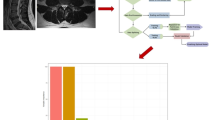Summary
Thirteen patients with recurrent symptoms after lumbar discectomy were evaluated. All the patients were enrolled in the study on the basis of clinical symptoms and signs only. The patients were examined with MRI, CT, and myelography in order to compare a) the clinical findings with the imaging investigations, b) the predictive value of the different investigations, and c) the clinical and investigative results with the operative findings. All patients were operated upon according to the clinical findings, and the surgical results were used as the final diagnosis. In six patients a new disc herniation was detected. In the remaining cases surgery revealed either scar tissue or nothing to explain the recurrence of the symptoms. The three imaging modalities were analysed by receiver operating characteristic (ROC) curves. The areas under the ROC curves were 0.68 for MRI, 0.83 for CT, and 0.43 for myelography. The difference in areas between CT and myelography was significant (p<0.05). The results indicate that CT has the highest predictive value for demonstrating the recurrence of a lumbar disc herniation.
Similar content being viewed by others
References
Begg CB, McNeil BJ (1988) Assessment of radiologic tests: Control of bias and other design considerations. Radiology 167: 565–569
Braun IF, Hoffman Jr JC, Davis PC, Landman JA, Tindall GT (1985) Contrast enhancement in CT differentiation between recurrent disk herniation and postoperative scar: Prospective study. AJR 145: 785–790
Bundschuh CV, Modic MT, Ross JS, Masaryk TJ, Bohlman H (1988) Epidural fibrosis and recurrent disk herniation in the lumbar spine: MR imaging assessment. AJR 150: 923–932
Burton CV, Kirkaldy-Willis WH, Yong-Hing K, Heithoff KB (1981) Causes of failure of surgery on the lumbar spine. Clin Orthop 157: 191–199
Cervellini P, Curri D, Volpin L, Bernardi L, Pinna V, Benedetti A (1988) Computed tomography of epidural fibrosis after discectomy: A comparison between symptomatic and asymptomatic patients. Neurosurgery 23 (6): 710–713
England WL (1988) An exponential model used for optimal threshold selection on ROC curves. Med Decis Making 8 (2): 120–131
Firooznia H, Kricheff II, Rafii M, Golimbu C (1987) Lumbar spine after surgery: Examination with intravenous contrast-enhanced CT. Radiology 163: 221–226
Hanley JA, McNeil BJ (1982) The meaning and use of the area under a receiver operating characteristic (ROC) curve. Radiology 143: 29–36
Hanley JA, McNeil BJ (1983) A method of comparing the areas under receiver operating characteristic curves derived from the same cases. Radiology 148: 839–843
Hochhauser L, Kieffer SA, Cacayorin ED, Petro GR, Teller WF (1988) Recurrent postdiskectomy low back pain: MR-surgical correlation. AJNR 9: 769–774
Hueftle MG, Modic MT, Ross JS, Masaryk TJ, Carter JR, Wilber RG, Bohlman HH, Steinberg PM, Delamarter RB (1988) Lumbar spine: Postoperative MR imaging with Gd-DTPA. Radiology 167: 817–824
Irstam L (1984) Differential diagnosis of recurrent lumbar disc herniation and postoperative deformation by myelography. An impossible task. Spine 9 (7): 759–763
Law JD, Lehman RAW, Kirsch WM (1978) Reoperation after lumbar intervertebral disc surgery. J Neurosurg 48: 259–263
Metz CE (1978) Basic principles of ROC analysis. Semin Nucl Med 8 (4): 283–298
Meyer JD, Latchaw RE, Roppolo HM, Ghoshhajra K, Deeb ZL (1982) Computed tomography and myelography of the postoperative lumbar spine. AJNR 3: 223–228
Ross JS, Masaryk TJ, Modic MT, Bohlman H, Delamater R, Wilber G (1987) Lumbar spine: Postoperative assessment with surface-coil MR imaging. Radiology 164; 851–860
Rovira M, Romero F, Ibarra B, Torrent O (1983) Prolapsed lumbar disk: Value of CT in diagnosis. AJNR 4: 593–594
Schubiger O, Valavanis A (1983) Postoperative lumbar CT: Technique, results, and indications. AJNR 4: 595–597
Sotiropoulos S, Chafetz NI, Lang P, Winkler M, Morris JM, Weinstein PR, Genant HK (1989) Differentiation between postoperative scar and recurrent disk herniation: Prospective comparison of MR, CT, and contrast-enhanced CT. AJNR 10: 639–643
Swets JA (1979) ROC analysis applied to the evaluation of medical imaging techniques. Invest Radiol 14: 109–120
Teplick JG, Haskin ME (1983) Computed tomography of the postoperative lumbar spine. AJNR 4: 1053–1072
Teplick JG, Haskin ME (1984) Intravenous contrast-enhanced CT of the postoperative lumbar spine: Improved identification of recurrent disk herniation, scar, arachnoiditis, and diskitis. AJR 143: 845–855
Author information
Authors and Affiliations
Rights and permissions
About this article
Cite this article
Albeck, M.J., Kjær, L., Præstholm, J. et al. Magnetic resonance imaging, computed tomography, and myelography in the diagnosis of recurrent lumbar disc herniation. Acta neurochir 102, 122–126 (1990). https://doi.org/10.1007/BF01405425
Issue Date:
DOI: https://doi.org/10.1007/BF01405425




